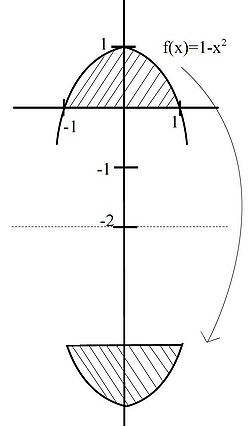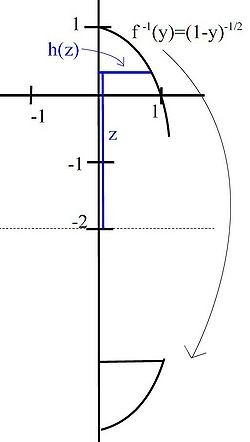Science:Math Exam Resources/Courses/MATH101/April 2010/Question 02 (a)
{{#incat:MER QGQ flag|{{#incat:MER QGH flag|{{#incat:MER QGS flag|}}}}}}
• Q1 (a) • Q1 (b) • Q1 (c) • Q1 (d) • Q1 (e) • Q1 (f) • Q2 (a) • Q2 (b) • Q2 (c) • Q3 (a) • Q3 (b) • Q3 (c) • Q3 (d) • Q4 • Q5 (a) • Q5 (b) • Q5 (c) • Q6 • Q7 • Q8 • Q9 •
Question 02 (a) |
|---|
|
Full-Solution Problem. Justify your answer and show all your work. Simplification of the answer is not required. The bounded region that lies between the -axis and the curve is revolved about the line Find the volume of the resulting solid of revolution. |
|
Make sure you understand the problem fully: What is the question asking you to do? Are there specific conditions or constraints that you should take note of? How will you know if your answer is correct from your work only? Can you rephrase the question in your own words in a way that makes sense to you? |
|
If you are stuck, check the hint below. Consider it for a while. Does it give you a new idea on how to approach the problem? If so, try it! |
Hint |
|---|
|
Sketch a diagram of the situation. |
|
Checking a solution serves two purposes: helping you if, after having used the hint, you still are stuck on the problem; or if you have solved the problem and would like to check your work.
|
Solution 1 |
|---|
|
We see the function and a sketch of the volume in the following figure. We use the shell method to find the volume. Therefore we need to determine what is the height and what is the integral variable . On the next figure we see, that the height is the inverse of the function And for this height the integral variable is the distance from to the rotating axis, which is So, we find z = y + 2 and for the height we calculate For convenience, we calculate half of the volume and drop the left half. Then we can take for z = y + 2. The boundaries of the integral must be the left and right edge of the interval for . Now we need to calculate the integral So, we get for the volume |
Solution 2 |
|---|
|
We see the function and a sketch of the volume in the following figure. We use the washers method to find the volume, where RO is the outer radius of the washer and RI is inner radius. From the diagram above, we see that , and . We are integrating along x, so the boundaries of the integral must be . Now we need to calculate the integral |
{{#incat:MER CT flag||
}}














![{\displaystyle y=[0,1]}](https://wiki.ubc.ca/api/rest_v1/media/math/render/svg/e83f131298fd965b09ac7dd4b2ed4ec40d750570)
![{\displaystyle {\begin{aligned}{\frac {1}{2}}V&=2\pi \int h(z)z\,dz\\&=2\pi \int _{0}^{1}(y+2){\sqrt {1-y}}\,dy\\&=2\pi \overbrace {\int _{0}^{1}\underbrace {y} _{=u}\underbrace {\sqrt {1-y}} _{=dv}\,dy} ^{\text{use integration by parts}}+2\pi \int _{0}^{1}2{\sqrt {1-y}}\,dy\\&=2\pi \left[y(1-y)^{\frac {3}{2}}(-{\frac {2}{3}})\right]_{0}^{1}+2\pi {\frac {2}{3}}\int _{0}^{1}(1-y)^{\frac {3}{2}}\,dy+2\pi 2\left[(1-y)^{\frac {3}{2}}\right]_{0}^{1}\\&=0+2\pi {\frac {2}{3}}\left[(1-y)^{\frac {5}{2}}(-{\frac {2}{5}})\right]_{0}^{1}-0+2\pi {\frac {4}{3}}\\&=2\pi {\frac {4}{15}}+2\pi {\frac {4}{3}}\\&={\frac {16\pi }{5}}\end{aligned}}}](https://wiki.ubc.ca/api/rest_v1/media/math/render/svg/9ff7a60fcf618697b98a372cdef803e1bca267ea)




![{\displaystyle x=[-1,1]}](https://wiki.ubc.ca/api/rest_v1/media/math/render/svg/e126e41300189a8baa1a89169dbe189feeb7e214)
![{\displaystyle {\begin{aligned}V&=\pi \int (R_{O}(x)^{2}-R_{I}(x)^{2})\,dx\\&=\pi \int _{-1}^{1}((3-x^{2})^{2}-4)\,dx\\&=\pi \int _{-1}^{1}(9-6x^{2}+x^{4}-4)\,dx\\&=\pi \int _{-1}^{1}(5-6x^{2}+x^{4})\,dx\\&=\pi \left[5x-2x^{3}+{\frac {1}{5}}x^{5}\right]_{-1}^{1}\\&=\pi \left[\left(5-2+{\frac {1}{5}}\right)-\left(5(-1)-2(-1)^{3}+{\frac {1}{5}}(-1)^{5}\right)\right]\\&=\pi \left(10-4+{\frac {2}{5}}\right)\\&={\frac {32\pi }{5}}\end{aligned}}}](https://wiki.ubc.ca/api/rest_v1/media/math/render/svg/342e24c5799965071cec07df245276cfdf25e6a3)
